VITAL TOOLS FOR THE WELLEQUIPPED AQUARIST
There are certain useful - indeed, indispensable - accessories that an aquarist
always needs at hand for everyday chores or the upkeep of the aquarium: a tool kit,
in fact.
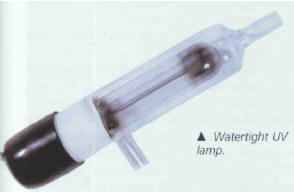
Thermometer
Absolutely essential. An alcohol thermometer, colored blue or red, is sufficiently
precise, although variations of more than 1В°C can be recorded between different
thermometers. Although mercury thermometers are more precise, they are also a little
more difficult to read. Whatever model is used, the thermometer is put into the
water, away from the source of heating, to avoid being directly affected by its
warmth. It can be attached to a weight, wedged into rocks, or stuck with a suction
pad.
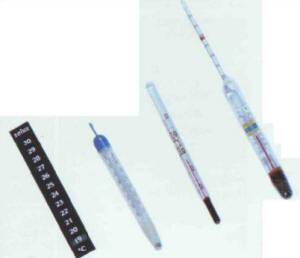
Various models of thermometers are available, some in conjunction
with a density meter. Not all have the same degree of precision.
External thermometers with liquid crystals have failed to convince most aquarists,
as their precision is not reliable.
Hydrometer
We have already discussed this, but it must be stressed that it is a vital instrument
for monitoring the density of sea water, i.e. the salt content.
Equipment for analyzing water
Several brands of simple tests, used to analyze water, are on the market. They
generally work on the basis of a change in the color of the water, which must be
compared with a scale printed on the packaging. They are sold separately or in complete
kits, although it is possible to restock a basic product when it runs out, without
having to buy the whole kit again. Four tests are more or less obligatory in fresh
water: general hardness (GH), carbonate hardness (CH), nitrites, and pH. The last
three are equally indispensable in sea water. There are other parameters that can
also be monitored by small pieces of analysis equipment: nitrates, ammonia, oxygen,
carbon dioxide, iron, and calcium (for marine invertebrate aquariums).
Landing nets
These are obviously absolutely essential for catching moving animals. The size
of the latter dictates the size of the net, along with the space available for handling
it. Choose a small net for small fish or aquariums with elaborate decor.
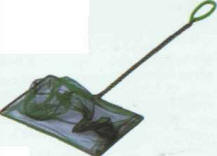
The size of a landing net depends not only on that of the
fish being caught but also on the space available in the aquarium for handling it.
However, it is not easy to catch fish in a landing net. Aquarists will almost
invariably tell you: as soon as you want to catch a particular fish, it seems to
see you coming! Once the net is put the water, pandemonium breaks loose, with foreseeable
consequences: wounded animals and the decor, both vegetable and inert, turn topsy-turvy.
One simple trick consists of putting the net into the tank at night, before switching
off the lights. The fish will get used to its presence, and so it will be easier
to catch the following morning, when you switch the lights back on.
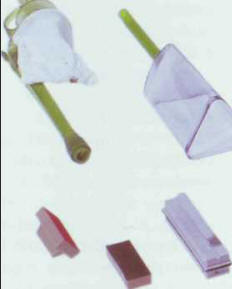
Magnets to clean the panes and vacuum cleaners connected
to an air pump are commonplace instruments for tank maintenance.
Another possibility is the use of two nets, with one remaining stationary to
receive the fish being pushed forward by the second. Landing nets must be disinfected
regularly with bleach (particularly after handling sick fish), and then rinsed several
times.
Miscellaneous equipment
You can also stock up with some other pieces of equipment that often turn out
to very practical:
- a long pipe for filling or draining the aquarium;
- plastic food containers to hold water;
- pincers for planting, though many aquarists prefer using their hands;
- a scraper furnished with a razor blade or a small abrasive scouring pad,
for cleaning the algae on the glass panes;
- a mini vacuum cleaner connected to the air pump, to siphon off waste products;
- suction pads, faucets, nozzles and connectors for air and water pipes, available
from commercial aquarium stores;
- an electronic timer for programming the lighting;
- a notebook enabling you to keep track of certain tasks: purchase dates for
fish, results of the analysis of water, maintenance schedule, etc.
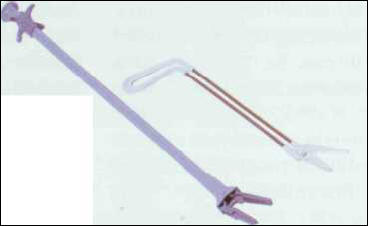
Garden pincers are very practical in deeper tanks.
The latter is particularly recommended for beginners, and also allows them to
record their personal observations on reproduction, sickness and the general behavior
of their fish.
CABLES AND PIPES: LABELING
A fully equipped aquarium quickly accumulates electric cables and pipes for air
and water and these have an irritating tendency to get mixed up, meaning that it
is sometimes difficult to find the right socket, or the pipe that needs to be disconnected.
To find them more easily, just stick a self-adhesive label at each end of a cable
or pipe and write on it the name of the corresponding element. In the case of aeration,
for example, a first label near the pump indicates which diffusers it is feeding,
while a second just before the point where the pipes enter the aquarium makes it
easier to locate the diffusers in question.
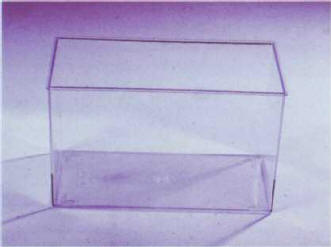
Small plastic tanks sometimes prove useful for maintenance
operations, or for providing a temporary home for plants and fish when an aquarium
is being repaired.
|